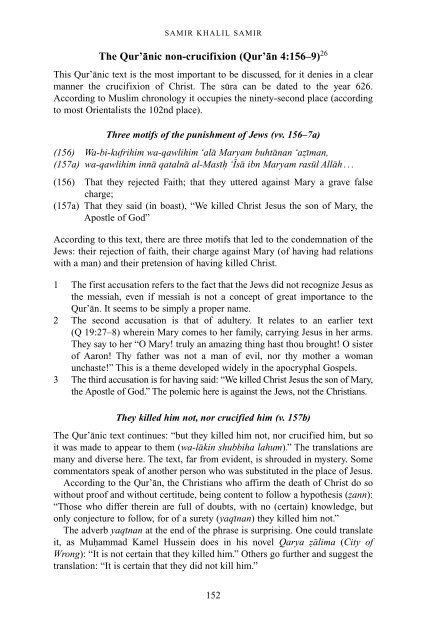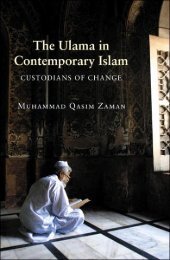The Qur'an in its historical context (pdf - Islam and Christian-Muslim ...
The Qur'an in its historical context (pdf - Islam and Christian-Muslim ...
The Qur'an in its historical context (pdf - Islam and Christian-Muslim ...
Create successful ePaper yourself
Turn your PDF publications into a flip-book with our unique Google optimized e-Paper software.
SAMIR KHALIL SAMIR<br />
<strong>The</strong> Qur’anic non-crucifixion (Qur’an 4:156–9) 26<br />
This Qur’anic text is the most important to be discussed, for it denies <strong>in</strong> a clear<br />
manner the crucifixion of Christ. <strong>The</strong> sura can be dated to the year 626.<br />
Accord<strong>in</strong>g to <strong>Muslim</strong> chronology it occupies the n<strong>in</strong>ety-second place (accord<strong>in</strong>g<br />
to most Orientalists the 102nd place).<br />
Three motifs of the punishment of Jews (vv. 156–7a)<br />
(156) Wa-bi-kufrihim wa-qawlihim ‘ala Maryam buhtanan ‘aziman,<br />
(157a) wa-qawlihim <strong>in</strong>na qatalna al-Masih ‘Isa ibn Maryam rasul Allah...<br />
(156) That they rejected Faith; that they uttered aga<strong>in</strong>st Mary a grave false<br />
charge;<br />
(157a) That they said (<strong>in</strong> boast), “We killed Christ Jesus the son of Mary, the<br />
Apostle of God”<br />
Accord<strong>in</strong>g to this text, there are three motifs that led to the condemnation of the<br />
Jews: their rejection of faith, their charge aga<strong>in</strong>st Mary (of hav<strong>in</strong>g had relations<br />
with a man) <strong>and</strong> their pretension of hav<strong>in</strong>g killed Christ.<br />
1 <strong>The</strong> first accusation refers to the fact that the Jews did not recognize Jesus as<br />
the messiah, even if messiah is not a concept of great importance to the<br />
Qur’an. It seems to be simply a proper name.<br />
2 <strong>The</strong> second accusation is that of adultery. It relates to an earlier text<br />
(Q 19:27–8) where<strong>in</strong> Mary comes to her family, carry<strong>in</strong>g Jesus <strong>in</strong> her arms.<br />
<strong>The</strong>y say to her “O Mary! truly an amaz<strong>in</strong>g th<strong>in</strong>g hast thou brought! O sister<br />
of Aaron! Thy father was not a man of evil, nor thy mother a woman<br />
unchaste!” This is a theme developed widely <strong>in</strong> the apocryphal Gospels.<br />
3 <strong>The</strong> third accusation is for hav<strong>in</strong>g said: “We killed Christ Jesus the son of Mary,<br />
the Apostle of God.” <strong>The</strong> polemic here is aga<strong>in</strong>st the Jews, not the <strong>Christian</strong>s.<br />
<strong>The</strong>y killed him not, nor crucified him (v. 157b)<br />
<strong>The</strong> Qur’anic text cont<strong>in</strong>ues: “but they killed him not, nor crucified him, but so<br />
it was made to appear to them (wa-lak<strong>in</strong> shubbiha lahum).” <strong>The</strong> translations are<br />
many <strong>and</strong> diverse here. <strong>The</strong> text, far from evident, is shrouded <strong>in</strong> mystery. Some<br />
commentators speak of another person who was substituted <strong>in</strong> the place of Jesus.<br />
Accord<strong>in</strong>g to the Qur’an, the <strong>Christian</strong>s who affirm the death of Christ do so<br />
without proof <strong>and</strong> without certitude, be<strong>in</strong>g content to follow a hypothesis (zann):<br />
“Those who differ there<strong>in</strong> are full of doubts, with no (certa<strong>in</strong>) knowledge, but<br />
only conjecture to follow, for of a surety (yaq<strong>in</strong>an) they killed him not.”<br />
<strong>The</strong> adverb yaq<strong>in</strong>an at the end of the phrase is surpris<strong>in</strong>g. One could translate<br />
it, as Muhammad Kamel Husse<strong>in</strong> does <strong>in</strong> his novel Qarya zalima (City of<br />
Wrong): “It is not certa<strong>in</strong> that they killed him.” Others go further <strong>and</strong> suggest the<br />
translation: “It is certa<strong>in</strong> that they did not kill him.”<br />
152



